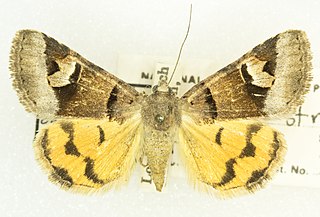The mulga dragon is a species of agamid lizard found in Western Australia. The species is up to 250 mm long, the length from snout to vent is 95 mm, with a long, slender tail that ends abruptly. The patterning over the legs and body is grey and brownish streaks. This provides an excellent camouflage on mulga trees, its usual habitat, it is also found beneath mulga leaf litter. Diporiphora amphiboluroides generally remains motionless and unobserved, this allows it to operate as an ambush predator and elude animals that would prey on it.

Diporiphora is a genus of lizards in the family Agamidae. Most species in the genus are endemic to Australia, but two are also found in New Guinea.
Harold George "Hal" Cogger is an Australian herpetologist. He was curator of reptiles and amphibians at the Australian Museum from 1960 to 1975, and Deputy Director of the museum from 1976 to 1995. He has written extensively on Australian herpetology, and was the first author to create a field guide for all Australian frogs and reptiles.

Hadena perplexa, the tawny shears or pod lover, is a species of moth of the family Noctuidae. It is found in Morocco, Algeria, Tunisia, Europe, Turkey, Israel, Lebanon, Syria, Jordan, Iran, Iraq, northern Asia, Central Asia, northern India and western China.

Drasteria perplexa, the perplexing or perplexed arches, is a moth of the family Erebidae. The species was first described by Henry Edwards in 1884. It is found in North America from Alberta and Saskatchewan south to Colorado and Arizona.

Diporiphora winneckei, also known commonly as the canegrass dragon, canegrass two-line dragon, blue-lined dragon, and Winnecke's two-pored dragon, is a species of small, terrestrial, diurnal lizard in the family Agamidae. The species is endemic to Australia. It is found throughout arid zones of Australia and is also a common house pet.
Diporiphora adductus, the Carnarvon dragon, is a species of agama found in Australia.
Diporiphora albilabris, the white-lipped two-line dragon or tar tar lizard, is a species of agama found in Australia.
Diporiphora bennettii, the Kimberley sandstone dragon or robust two-line dragon, is a species of agama found in Australia.

Diporiphora bilineata, the northern two-line dragon or two-lined dragon, is a species of agama found in Australia and Papua New Guinea.

Diporiphora convergens, the Crystal Creek two-lined dragon, is a species of agama found in Australia.
Diporiphora jugularis, the black-throated two-pored dragon, is a species of agama found in Australia and Papua New Guinea.

Diporiphora linga, the pink two-line dragon, is a species of agama found in Australia.
Diporiphora margaretae is a species of agama found in the Kimberley region of Australia.
Diporiphora nobbi, the nobbi lashtail or nobbi, is a species of agama found in Australia.
Diporiphora paraconvergens, the grey-striped western desert dragon, is a species of agama found in Australia.
Diporiphora pindan, the Pindan two-line dragon or Pindan dragon, is a species of agama found in Australia.
Diporiphora superba, the superb two-line dragon, is a species of agama found in Australia.
Diporiphora valens, the southern Pilbara spinifex dragon , southern Pilbara tree dragon, or Pilbara two-line dragon, is a species of agama found in Australia.
Diporiphora vescus, the northern Pilbara tree dragon, is a species of agama found in Australia.






